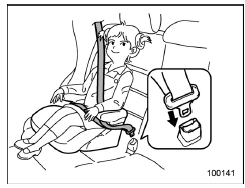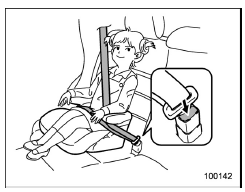Subaru Crosstrek Owners Manual: Installing a booster seat
WARNING
- Child restraint systems and seatbelts can become hot in a vehicle that has been closed up in sunny weather; they could burn a small child. Check the child restraint system before you place a child in it.
- Do not leave an unsecured child
restraint system in your vehicle.
Unsecured child restraint systems can be thrown around inside of the vehicle in a sudden stop, turn or accident; they can strike and injure vehicle occupants as well as result in serious injuries or death to the
child.
CAUTION
When you install a child restraint system, follow the manufacturer's instructions supplied with it. After installing the child restraint system, check to ensure that it is held securely in position. If it is not held tight and secure, the danger of your child suffering personal injury in the event of an accident may be in-creased.

1. Place the booster seat in the rear seating position and sit the child on it. The child should sit well back on the booster seat.
2. Run the lap and shoulder belt through or around the booster seat and the child following the instructions provided by its manufacturer.
3. Insert the tongue plate into the buckle until you hear a click. Take care not to twist the seatbelt.
Make sure the shoulder belt is positioned across the center of child's shoulder and that the lap belt is positioned as low as possible on the child's hips.

4. To remove the booster seat, press the release button on the seatbelt buckle and allow the belt to retract.
WARNING
- Never use a belt that is twisted or reversed. In an accident, this can increase the risk or severity of injury to the child.
- Never place the shoulder belt under the child's arm or behind the child's back. If an accident occurs, this can increase the risk or severity of injury to the child.
- The seatbelt should fit snugly in
order to provide full restraint.
Loose fitting belts are not as effective in preventing or reducing injury.
- Place the lap belt as low as possible on the child's hips. A high-positioned lap belt will increase the risk of sliding under the lap belt and of the lap belt sliding up over the abdomen, and both can result in serious internal injury or death.
- Make sure the shoulder belt is positioned across the center of child's shoulder. Placing the shoulder belt over the neck may result in neck injury during sudden braking or in a collision.
 Installing forward facing child restraint
Installing forward facing child restraint
WARNING
Before installing a child restraint
system, be sure to confirm that the
seatback is securely locked into
place. Otherwise, in an accident,
serious injury or death could result.
1. Shake ...
 Installation of child restraint systems by use of lower and tether
anchorages (LATCH)
Installation of child restraint systems by use of lower and tether
anchorages (LATCH)
WARNING
Child restraint systems and seatbelts
can become hot in a vehicle
that has been closed up in sunny
weather; they could burn a small
child. Check the child restraint
system before ...
Other materials:
Adjustment
CONTINUOUSLY VARIABLE TRANSMISSION(TR580) > Forward Clutch AssemblyADJUSTMENT1. Install the thrust bearing to the internal gear.NOTE:Face the temper color surface to the reverse brake side.2. Measure depth “A” from the ST upper face to the washer mounting surface.ST 499575600GAUGE3 ...
Dtc b16f9 door sensor rh recognition error
AIRBAG SYSTEM (DIAGNOSTICS) > Diagnostic Chart with Trouble CodeDTC B16F9 DOOR SENSOR RH RECOGNITION ERRORDiagnosis start condition:Ignition voltage is 10 V to 16 V.DTC detecting condition:• Front door impact sensor (RH) is misinstalled.• Airbag control module is faulty.CAUTION:Before ...
Caution
CRUISE CONTROL SYSTEM (DIAGNOSTICS) > General DescriptionCAUTIONAirbag system wiring harness is routed near the cruise control command switch.CAUTION:• Do not use the electrical test equipment on the airbag system wiring harnesses and connector circuits.• Be careful not to damage the ...
